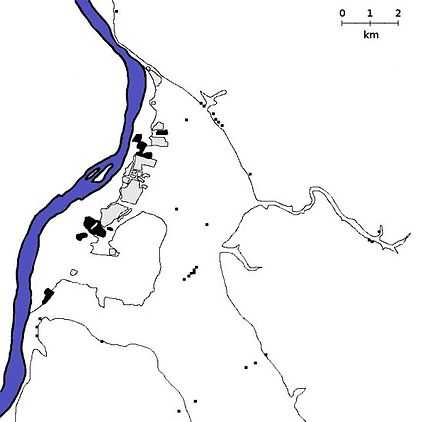Boundary Stelae of Akhenaten
The Boundary Stelae at the city of Amarna were constructed between Year 5 and Year 8 in the reign of Akhenaten.
Naming
There have been sixteen stelae found at this site, each of which has been labeled with a letter. Of the sixteen, three are located on the western side of the Nile. These have been distinguished as the letters A, B and F. The other twelve are located on the eastern side of the Nile and are represented by the letters H, J, K, L, M, N, P, Q, R, S, U, V, X.[1] This system of labeling the stelae was created by the English Egyptologist Flinders Petrie and is still used today.
Work done on the stelae
Claude Sicard, a Jesuit priest, first discovered the site in 1714 but the work he did was minimal. More work was done in the early and mid-1800s by Joseph Bonomi, John Wilkinson and others. Karl Lepsius also did some work on the site thanks to some funding from the Prussian government. Flinders Petrie was the first to categorize the stelae in a systematic way using letters. However, the work of Norman de Garis Davis and William J. Murnane contributed the most knowledge of the site than anyone else.[2] Stela 'H' was only found in 2006.
Stelae
Akhenaten built the city of Akhetaten for the sun deity Aten. He also decided to make the city both the political and religious capital. The stelae he built around the perimeter of the city explained why the city was built, what he planned on doing in honor of Aten, and described the projected layout of the city. Some of them also depict Akhenaten and his royal family worshiping Aten. Sadly, many of “these rock-hewn stelae which marked the exact bounds of the city of Akhetaten are now in a sad state”.[3] This is due to a number of things including natural weathering, and being built in a bad type of rock. Stelae P was blown up in 1906.[4] Though many of the stelae are in bad shape, Stelae A is still in fairly good shape and is also easy for archaeologists and tourists to get to. The building of the city and the transition that Akhenaten made to the religion affected the state of Egypt. Many of the temples were closed down. Though people still worshiped the old gods, they were unable to visit the temples and participate in the ceremonies associated with the gods.
Damage
Stelae P was dynamited around 1908, and Stelae S was extensively damaged in 1984 by looters and then dynamited in 2004, totally destroying it.[5] The stelae were subjected to further vandalism in February 2013.[6]
References
- ↑ http://amarnaproject.com/pages/amarna_the_place/boundary_stelae/index.shtml
- ↑ Murnane, William J. and Charles C. Van Siclen III. 1993. The Boundary Stelae of Akhenaten. Kegan Paul International: London. pp. 2-6
- ↑ ldred, Cyril. 1989. Akhenaten King of Egypt. Thames and Hudson: London. p. 45
- ↑ Aldred, Cyril. 1989. Akhenaten King of Egypt. Thames and Hudson: London. p. 45
- ↑ "Boundary Stelae".
- ↑ Hartley, Aiden (9 November 2013). "The new tomb raiders". The Spectator (UK). Retrieved 10 November 2013.
External links
![]() Media related to Boundary Steles of Akhenaten at Wikimedia Commons
Media related to Boundary Steles of Akhenaten at Wikimedia Commons
| ||||||||||||||||
